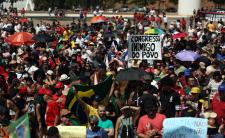Introduction
With an area of 8.5 million square km and a population of over 202 million, Brazil is the largest and most populated Latin American country. After more than three hundred years of Portuguese rule, Brazil became independent in 1822. It first adopted a monarchical system until 1889, when a republic was established. Since 1889, the country has had several forms of government, including state autonomy and centralization, authoritarianism, and democracy.
Constitutional history
Brazil’s independence was proclaimed on September 7th 1822, by the then Prince of Portugal, who became Pedro I, Emperor of Brazil. Since then, the country wrote seven other constitutions beginning with the constitution of 1824. The 1824 Constitution gave the Emperor wide control over governing institutions, such as the legislature and provincial governments and lasted until 1889, when Pedro II was overthrown and the Republic of Brazil was formed.
1891 Constitution
This first republican constitution was very similar to the United States Constitution. It established a presidential system and male universal suffrage from the age of 21. It contained provisions for separation of powers, checks and balances, a bicameral legislature, direct elections, and created a Federal Chamber. The former provinces were declared States, giving these individual entities a strong presidential or gubernatorial character.
1934 - 1937 Constitutions
In 1930, Getulio Vargas organized a military revolt and led a Coup de’ Etat. His government created a new Constitution in 1934. A couple of years later, Vargas faced a counter-revolution, forcing him to stage a coup, after which he began a new constitutional process. The resulting 1937 Constitution was authoritarian, concentrating executive and legislative powers in the President, who was the supreme authority of the State, elected by indirect elections for a term of six years. Article 187 of the Constitution required conducting a plebiscite in order to approve the text before it entered into force, but it was never held. The President had powers to appoint the Governors of the provinces, who in turn appointed the mayors of cities. As this was a de facto rule, Vargas legislated by decree. During this period all political parties were dissolved; the Congress was closed; and individual rights and guarantees were suspended. The government had a great intervention in the economy, and the subsoil and waterfalls were nationalized. The 1937 Constitution allowed Vargas to proclaim a dictatorship called the New State (Estado Nôvo) and to remain in power for another decade.
The 1946 Constitution
The 1946 Constitution replaced the New State’s dictatorship of Getúlio Vargas after he was overthrown by his war minister. A representative democracy was established and a new President, Eurico Gaspar Dutra, was elected for five years. A constituent assembly drafted a more balanced and liberal Constitution which re-established basic individual rights and the separation of powers. The document also maintained an important role of the state in the nation’s economy and reflected the influence of the U.S. Constitution with respect to federalism.
The 1967 -1969 Constitutions
In the following years, the 1946 Constitution suffered many amendments through Institutional Acts which severely compromised the document’s spirit and eliminated its democratic character. It was replaced by a new constitution in 1967. This document was again changed through a constitutional reform in 1969. Both constitutions were characterized by centralized power in the executive, in particular in the President, as they sought to institutionalize the military regime. The presidential term of office was increased from four to five years, and the President was given more power to decree laws related to taxation, creation of public employment, and the determination of salaries for civil servants. Institutional acts were used by military leaders to remove opposition members from the Congress.
The transition to the 1988 Constitution
In the 1970s, the military regime faced popular uprisings and dissatisfaction as economic progress began to slow. The transition from authoritarian rule to democracy started in 1974 when President Ernesto Geisel and his Chief of Cabinet, General Golbery de Couto e Silva conducted a gradual process of political opening—or liberalization—which was characterized by small advances that limited the establishment of a full democracy. The first important measure was the organization of free congressional elections in 1974. In 1982 the military allowed direct elections for state governors and gradually increased federal transfers to municipal governments. Additionally, a new law on political parties led to an opening of the political life.
In 1985, the government approved the convocation of the National Constituent Assembly (Assembléia Nacional Constituinte--ANC) to draft a new constitution. For the 1988 Constitution drafting process, the 559-member Assembly adopted a "from scratch" participatory methodology and organized public hearings. After twenty months of deliberation, the ANC produced the 1988 “citizen constitution.” This text required each state to rewrite its constitution and each municipality to elaborate its Organic Law.
Structure of Government under the 1988 Constitution as amended
Under the current Constitution, Brazil is a presidential, federal republic. Through an amendment in 1996, municipalities were incorporated with states as part of the federation. Consequently, the country is composed of 26 states and the Federal District (Brasilia). The federal, state, and municipal governments have their own legislative, executive and judicial institutions. The aim of the 1988 text was to give state and municipal governments administrative autonomy and responsibility for policy implementation, decentralizing the federal power.
The executive branch
The executive is headed by a President who is directly for a four year term. He or She is both head of the state and head of the government. Although all of Brazil's constitutions since 1891 prohibited consecutive presidential terms, a 1997 amendment changed this rule. A president now has no limit on number of terms but may not serve more than two terms consecutively. Of the 48,000 positions the Brazilian President has the power to appoint–including Ministers of State, military officers, and judges—only ambassadors, higher-court judges, the solicitor general, and Central Bank directors must have Senate approval.
The legislative branch
The federal legislative branch is bicameral, consisting of the Chamber of Deputies and the Senate. There are 513 federal deputies: 3 members from each state and federal district are elected to serve eight-year terms. One-third and two-thirds of members are alternately elected every four years. 81 senators are elected by proportional representation from each state and serve four-year terms.
The judicial branch
The federal judiciary is composed of the Federal Supreme Court, the Superior Court of Justice, regional federal courts, labour courts, the Electoral court and the Military court. The Supreme Federal Court is the highest court and consists of 11 justices appointed by the president and approved by the Senate. The Court can declare federal, state, and municipal laws unconstitutional and therefore null.
New constitutional developments and challenges
In 2013, the Brazilian government faced a wide-spread national dissatisfaction, expressed in the country’s largest protests in 20 years on a range of issues. These included corruption accusations, the costs associated with hosting the 2014 FIFA World Cup, and the general high living costs. President Dilma Rousseff sought to overcome this situation, proposing to vote on amending Brazil's constitution by calling for a constitutional assembly to reform the political system.
Structure of Government
Timeline for Constitution Building Process
| 1500 | Portuguese land in the area and claim it to the Portuguese crown |
| 1822 | Son of Portuguese king declares independence from Portugal and crowns himself Peter I, Emperor of Brazil. |
| 1889 | Monarchy overthrown, federal republic established |
| 1930 | Revolt places Getulio Vargas at head of provisional revolutionary government. |
| 1937 | Vargas leads coup, rules as dictator with military backing. Economy placed under authoritarian state control, start of social welfare revolution and reform of laws governing industry. |
| 1945 | Vargas ousted in military coup. Elections held under caretaker government. New constitution returns power to states. |
| 1964 | Goulart ousted in bloodless coup, flees into exile. Military rule associated with repression but also with rapid economic growth based on state-ownership of key sectors. |
| 1974 | General Ernesto Geisel becomes president, introduces reforms which allow limited political activity and elections. |
| 1988 | New constitution reduces presidential powers. |
| 1997 | Constitution changed to allow president to run for re-election |
| 2013 | June - A wave of protests sweeps the country. People take to the streets in dozens of cities to demonstrate over woeful public services, rising public transport costs and the expense of staging the 2014 World Cup. The protests continue into the autumn. |
References
BBC News. Latin America & Caribbean: Brazil Profile. Web. 2014 http://www.bbc.com/news/world-latin-america-19359111.
Central Intelligence Agency, The World Factbook: Brazil, available at https://www.cia.gov/library/publications/the-world-factbook/geos/br.html.
José Fonseca. A Brief History of Brazil. The New York Times. Web. http://www.nytimes.com/fodors/top/features/travel/destinations/centralandsouthamerica/brazil/riodejaneiro/fdrs_feat_129_9.html?pagewanted=1.
| Branch | Hierarchy | Appointment | Powers | Removal | ||||||||
|---|---|---|---|---|---|---|---|---|---|---|---|---|
| Executive |
|
|
|
|
||||||||
| Legislative |
|
|
|
|
||||||||
| Judicial |
|
|
|
|
Executive
President
Appointment
Directly elected by absolute majority for a four year term
Powers
- Executive head of the State. All executive powers of the State are vested in the president.
- Appoints and dismiss the Ministers of State.
- Appoints, after approval by the Federal Senate, the Justices of the Federal Supreme Court and of the Superior Courts, the Governors of the Territories, the Attorney General of the Republic, the president and directors of the Central Bank, and other civil servants.
- Commences the legislative procedure.
- Maintains relations with foreign States.
- Decrees a state of defense and state of siege.
Removal
- Upon impeachment procedure
- In common criminal offenses, if the accusation is received by the Federal Supreme Court.
- In the event of criminal conduct, after proceedings are instituted by the Federal Senate.
Vice- presidents
Appointment
- Elected simultaneously with the President.
Powers
- Assists the President whenever called by the President for special missions.
- Replaces the President in the event of impediment and succeeds him in the event of vacancy.
Removal
- Upon impeachment procedure
- Upon impediment or vacancy
- Upon criminal offenses and criminal conduct
President
Appointment
Directly elected by absolute majority for a four year termPowers
- Executive head of the State. All executive powers of the State are vested in the president.
- Appoints and dismiss the Ministers of State.
- Appoints, after approval by the Federal Senate, the Justices of the Federal Supreme Court and of the Superior Courts, the Governors of the Territories, the Attorney General of the Republic, the president and directors of the Central Bank, and other civil servants.
- Commences the legislative procedure.
- Maintains relations with foreign States.
- Decrees a state of defense and state of siege.
Removal
- Upon impeachment procedure
- In common criminal offenses, if the accusation is received by the Federal Supreme Court.
- In the event of criminal conduct, after proceedings are instituted by the Federal Senate.
Vice- presidents
Appointment
- Elected simultaneously with the President.
Powers
- Assists the President whenever called by the President for special missions.
- Replaces the President in the event of impediment and succeeds him in the event of vacancy.
Removal
- Upon impeachment procedure
- Upon impediment or vacancy
- Upon criminal offenses and criminal conduct
Legislative
House of Representatives
Appointment
- Elected by the proportional system in each State, Territory and the Federal District.
- Each Territory elects four Representatives.
- One third and two thirds of the representatives are renewed every four years, alternately
Powers
- Authorizes the institution of legal action against the President and Vice President of the Republic and the Ministers of State.
Removal
- Upon misbehavior
- Upon failure to attend one third of the ordinary sessions of his or her Chamber of Congress.
- Upon loss or suspension of political rights
- Upon a final an un-appealable criminal conviction
Federal Senate
Appointment
- Composed of members representing the States and the Federal District, elected by majority vote.
- Each State and the Federal District elects three Senators with term of office of eight years.
Powers
- Authorizes foreign transactions of a financial nature.
- Sues the President, the Vice President and the Ministers for criminal conduct.
- Approves by absolute majority and by secret ballot the removal from office of the Attorney General of the Republic.
Removal
- Upon misbehavior
- Upon failure to attend one third of the ordinary sessions of his or her Chamber of Congress.
- Upon loss or suspension of political rights
- Upon a final an un-appealable criminal conviction
House of Representatives
Appointment
- Elected by the proportional system in each State, Territory and the Federal District.
- Each Territory elects four Representatives.
- One third and two thirds of the representatives are renewed every four years, alternately
Powers
- Authorizes the institution of legal action against the President and Vice President of the Republic and the Ministers of State.
Removal
- Upon misbehavior
- Upon failure to attend one third of the ordinary sessions of his or her Chamber of Congress.
- Upon loss or suspension of political rights
- Upon a final an un-appealable criminal conviction
Federal Senate
Appointment
- Composed of members representing the States and the Federal District, elected by majority vote.
- Each State and the Federal District elects three Senators with term of office of eight years.
Powers
- Authorizes foreign transactions of a financial nature.
- Sues the President, the Vice President and the Ministers for criminal conduct.
- Approves by absolute majority and by secret ballot the removal from office of the Attorney General of the Republic.
Removal
- Upon misbehavior
- Upon failure to attend one third of the ordinary sessions of his or her Chamber of Congress.
- Upon loss or suspension of political rights
- Upon a final an un-appealable criminal conviction
Judicial
The Federal Supreme Court
Appointment
- Eleven Justices appointed by the President, approved by the absolute majority of the Federal Senate.
Powers
- Responsible for safeguarding the Constitution.
- Process and adjudicate direct actions of unconstitutionality of a federal or state law or normative act.
- Process litigations between a foreign State or international organization and the Republic, a State, the Federal District or a Territory.
Removal
- Upon resignation
- Upon compulsory retirement (at seventy years old)
- Upon impeachment
The Federal Supreme Court
Appointment
- Eleven Justices appointed by the President, approved by the absolute majority of the Federal Senate.
Powers
- Responsible for safeguarding the Constitution.
- Process and adjudicate direct actions of unconstitutionality of a federal or state law or normative act.
- Process litigations between a foreign State or international organization and the Republic, a State, the Federal District or a Territory.
Removal
- Upon resignation
- Upon compulsory retirement (at seventy years old)
- Upon impeachment






Share this article